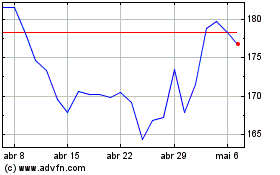Ethiopian Airlines Black Boxes Showed 'Clear Similarities' With Lion Air Crash
17 Março 2019 - 3:13PM
Dow Jones News
By Gabriele Steinhauser and Robert Wall
ADDIS ABABA, Ethiopia -- Data retrieved from the black boxes of
a crashed Ethiopian Airlines plane showed similarities to that from
the Lion Air flight that plunged into the Java Sea in October,
Ethiopia's transport minister said Sunday, adding to the pressure
on aircraft maker Boeing Co.
"Clear similarities were noted between Ethiopian Air Flight 302
and Indonesian Lion Air Flight 610, which will be the subject of
further study during the investigation," Transport Minister
Dagmawit Moges said. Both flights were on Boeing 737 MAX 8
aircraft.
Ms. Moges declined to give details of the similarities that had
been identified, including whether Boeing's new anti-stalling
software that has been associated with the Lion Air flight had been
activated. She spoke after French air accident investigations
bureau BEA had sent the data from both the cockpit voice recorder
and the flight data recorder to Ethiopian authorities.
Investigators from both Ethiopia and the U.S. National
Transportation Safety Board have validated the data, she said, and
a preliminary report on the accident will be published within 30
days. Representatives from the U.S. Federal Aviation Administration
and its European counterparts were also present in the downloading
of black box data.
U.S. authorities last week grounded the 737 MAX after saying it
had found enough similarities between the two crashes to take the
rare step of keeping the aircraft out of the air. The move followed
similar actions by a number of regulators around the world.
American and Canadian officials cited satellite data showing a
similar flight path between the two planes -- both new jets that
crashed after just a few minutes.
Boeing has said it believes the plane is safe but agreed with
the grounding.
The Ethiopian findings of similarities between the two crashed
planes come from an initial analysis of data retrieved from the
plane's black boxes. Voice recordings and flight data contained in
these devices are typically the most important components in any
crash probe. The similarities add a new level of scrutiny on the
Boeing jet.
Accident investigators in the probe of the earlier crash, which
killed all 189 people aboard the Lion Air flight, have said they
are looking the plane's anti-stall system that repeatedly pushed
the 737 MAX's nose down. They are also looking at plane
maintenance. The airline said the plane was well maintained.
The Lion Air crew battled the airplane for the 11 minutes after
takeoff before the plane crashed. The system, based on erroneous
sensor inputs, thought the crew was about to stall the plane and
repeatedly pushed its nose down, accident investigators said in a
preliminary report. The pilots tried to recover but eventually lost
control.
In the Ethiopian Airlines crash, the flight data recorder should
help investigators determine the exact nature of the problem and
what actions the crew took to deal with the situation. The plane
crashed into a field outside Addis Ababa Sunday a mere six minutes
after taking off from the Ethiopian capital's airport, killing all
158 passengers and crew on board.
Detailed analysis of the data can take months, but preliminary
conclusions can be drawn within hours or days.
A particular focus of the review of flight data recorder
information is expected to be whether the plane's stall-prevention
system activated.
Some data broadcast by the Ethiopian plane and collected by
satellite, as well as physical evidence at the crash site, has led
authorities to suspect that may have been the case. The plane's
pilot also reported flight control problems before all contact was
lost.
U.S. officials have said they would keep Boeing's MAX fleet
grounded until it can determine from the Ethiopian plane's black
boxes what happened.
Tearful memorial services were held at Addis Ababa's main
Orthodox cathedral and the Ethiopian Airlines headquarters on
Sunday for the Ethiopian crew and passengers who died in the crash.
But the caskets on display didn't contain bodies. Ethiopian
officials have said that it will take five to six months to
identify remains of victims through DNA analysis due to the high
speed at which the aircraft collided with the ground.
Write to Gabriele Steinhauser at gabriele.steinhauser@wsj.com
and Robert Wall at robert.wall@wsj.com
(END) Dow Jones Newswires
March 17, 2019 13:58 ET (17:58 GMT)
Copyright (c) 2019 Dow Jones & Company, Inc.
Boeing (NYSE:BA)
Gráfico Histórico do Ativo
De Mar 2024 até Abr 2024

Boeing (NYSE:BA)
Gráfico Histórico do Ativo
De Abr 2023 até Abr 2024
